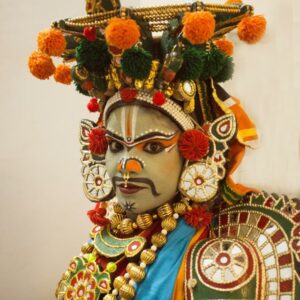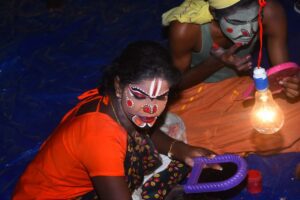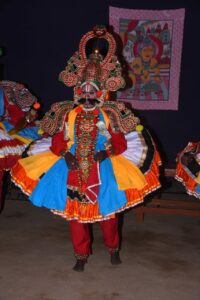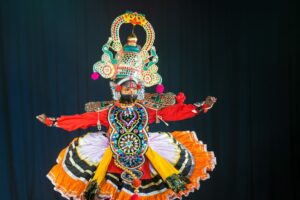
Thilagavathi Palani will perform on 19 December as part of Rasoham's Kutty Kutchery Festival at Medai - The Stage. (Supplied)
Every time someone asks artiste Thilagavathi Palani about her profession, she begins with, “Kattaikoothu theriyuma? (Do you know Kattaikoothu?)” If the response is affirmative, they quickly delve into shared interests.
However, if the answer is negative, Palani ensures she takes the time to explain.
“I ask if they are acquainted with Therukkoothu – a traditional form of street play. These terms are often used interchangeably, yet they depict two distinct types of performances, each sharing certain similarities. Therukkoothu entails mobile performances by artistes during a procession dedicated to the village deity. On the other hand, Kattaikoothu signifies overnight narrative performances held at a fixed venue, featuring an ensemble of approximately fifteen actors and musicians,” she explains in detail.
“Kattaikoothu is a traditional art form involving Kattai-based costumes and jewellery,” she adds.
Going the extra mile to educate people about Kattaikoothu isn’t just a choice but a necessity and the core purpose of Thilagavathi Palani’s life.
“I aim to preserve this art form, enabling marginalised artistes like myself to sustain a livelihood through it,” shares the recipient of the Sangeet Natak Akademi’s Yuva Puraskar award.

Thilagavathi runs the Sri Krishna Kattaikuttu Kuzhu in Kanchipuram. (Supplied)
Recognised as the first female Kattaikoothu artiste, she manages her troupe – Sri Krishna Kattaikuttu Kuzhu, situated near Kanchipuram. Her upcoming performance is scheduled at Rasoham’s Kutty Kutchery Festival on 19 December in Chennai at Medai.
Celebrating her 20th year since embarking on her journey of learning, performing, and eventually teaching this art form, she shares her experiences with South First.
Q. Can you give us a peek into your upcoming performance?
A. The upcoming performance will be a performative conversation, centered on the tradition of Kattaikoothu. Kattaikoothu is traditionally performed on episodes from the Mahabharatha. We’ve chosen a segment – Kuravanji. This section will encapsulate traditional Kattaikoothu kalai (art) for about 45 minutes to an hour.
Following this, we aim to dedicate 15 minutes to have a character from the segment itself convey a social message through songs, comedy, and more, engaging the audience interactively. Additionally, there will be time allocated for audience Q&A, inviting them to dance with us and learn steps, enabling an interactive experience.
Q. The first female artiste in Kattaikoothu – you carry a certain weight. How has the journey been?
A. Challenges are inevitable for any pioneer, especially a woman aiming to break barriers. I encountered numerous obstacles. Being a woman often comes with the expectation of marriage, leading to significant personal struggles. Kattaikoothu is a male-dominated space.

The upcoming performance will be a performative conversation. (Supplied)
Earlier, men used to portray the characters of women. Now, with the emergence of women, there is also jealousy, as women have started taking on their roles – in a sense, claiming their space.
Q. How supportive has your extended circle been in your journey, considering your parents’ support?
A. The support from my extended family has been somewhat challenging. Despite my parents’ encouragement, there’s been resistance from relatives. There’s a reluctance to accept unconventional paths for women due to entrenched societal beliefs about expected behaviour. They often fail to recognise the significance of my pursuits.
View this post on Instagram
A post shared by RASOHAM – Chennai Cultural Arts Organisation | Regd. NGO | (@rasoham_official)
Initially, they tried to dictate societal norms to me. Now, they question my choices. I’ve chosen to disregard their opinions to pursue my aspirations. Otherwise, achieving my goals would be impossible!
Q. As men traditionally portray female roles in koothu, have you encountered any resistance while performing male roles as a female artiste?
A. During my school days, I often portrayed male characters. However, within my own troupe, I predominantly undertake female roles. Yet, I do occasionally take on character roles like Krishna, Saguni, or Balarama to maintain the audience’s interest and diversity in my performances.

Palani is a national award winner. (Supplied)
I’m drawn towards roles that require nuanced acting abilities. In Tamil cinema, Superstar Rajinikanth is known for his screen presence and style, while Kamal Haasan typically chooses roles that emphasise acting skills. Naan Kamal Haasan madhiri (I am like Kamal Haasan). I relate more to Kamal’s approach, preferring roles that offer depth and allow acting to take centre stage, presenting multiple layers of character portrayal.
Q. What does it mean to be a Kattaikoothu artiste in a man’s world?
A. Within the community, there’s an underlying ego. There’s a reluctance when females take the forefront, even if they possess superior skills compared to male counterparts. For instance, if there’s a pre-performance ritual to be performed on stage or in the green room, it’s the men who will do it – simply because – they are men. I have been facing these challenges in recent years, But I am hoping to break the barriers similar to the many walls I’ve overcome previously.
Q. Have you been able to address these issues with fellow artistes?
A. (Laughs) In our society, the aspect of teaching men how to cordially address or resolve issues seems to have been overlooked. Efforts to communicate and resolve these matters have unfortunately proven unsuccessful. There’s a significant lack of dialogue in such instances. Nevertheless, any conflicts that arise off-stage are kept within those boundaries. We make certain that these issues don’t spill onto the stage during our performances.

Encouraging more women to join Kattaikoothu poses a current challenge. (Supplied)
Challenges within our community, including clashes of egos and politics, persist. At times, these struggles have had an impact on my artistic journey. There have been moments when I contemplated departing from this profession in search of personal happiness. However, my art and association with Krishna Kattaikoothu Kuzhu remain central to my identity, serving as an anchor during these challenges.
Q. Has there been a moment that significantly impacted or shaped your life during this extensive journey?
A. An important moment in my journey was realising that I was the first recognised female Kattaikoothu artiste, a chance that generations of women before me had missed.
During my time with artiste and social worker Sangeetha Isvaran from Wind Dancers Trust, I received invaluable guidance. Recognising my potential, she encouraged me to move to Chennai and join an NGO while she was travelling. Those three months gave me the confidence to navigate life independently in Chennai. Even in challenging moments, Sangeetha’s support has been a major influence in my life.
Q. What efforts are being made to encourage more women into the art?
A. Encouraging more women to join Kattaikoothu poses a current challenge. The school where I learned this art form, led by my mentor P Rajagopal, blended education with koothu, which appealed to parents due to its educational value, residency offerings, and overall advantages. However, despite passionate learning, many girls tend to discontinue their pursuit after marriage.
At present, despite our efforts to encourage women to join, various obstacles prevent their involvement. These challenges include distractions like mobile phone addiction and societal stigmas related to menstruation, restricting women from performing after reaching puberty. Additionally, some individuals are apprehensive about pursuing this profession due to perceived limitations in income potential.
Q. But is the income potential feasible to run a living?
A. There is substantial income potential within this field. Many in my group have sustained themselves, paid for college fees, and earned degrees through this koothu. Unfortunately, people fail to understand its profitability, fame, and platform for sharing messages.
In our company, the least experienced member typically earns between ₹500 to ₹1,000 rupees per performance. Assuming they participate in approximately 150 performances annually, they earn about ₹2 lakh on average. This is just from koothu.
Q. What is the future of Kattaikoothu like?
A. Currently, approximately a few thousand artistes are practising this art form in Tamil Nadu. In areas like Kanchipuram, Arani, Thiruvannamali, and Ranipet, there could be roughly 2,000 or more artistes involved in koothu.
However, the future of Kattaikoothu appears uncertain. Even in our school, there have been several dropouts not only among female but also among male students. Despite our attempts to engage new students by reaching out to different towns, there’s limited interest. We’re striving to ensure that someone can continue the legacy of this art form after us.
Q. Do all artistes get the opportunity to perform in cities other than their local areas?
A. No, not all artistes get the chance to perform in Chennai or other cities. Performances primarily occur locally, especially during festival seasons. Established companies typically perform around 250-300 nights during these times. Last year, we accomplished 150 performances, and this year, we’re aiming for 200.
Q. Earlier this year, you were one of the awardees of the Grant Project of Sumanasa Foundation. What can we expect from it?
A. I am currently engaged in developing a solo performance supported by the grant I received from the Sumanasa Foundation. Typically, Kattaikoothu is a collaborative art form, making the portrayal of a narrative as a solo artist quite challenging. However, I am thrilled to endeavour to narrate the story of Alli, a character from the Mahabharata.

The month of Margazhi is an off-season for koothu artistes. (Supplied)
This tale, predominantly centred on a female character, has not received much attention previously. I deeply resonate with this character’s courage, independence, and leadership qualities as she manages her kingdom. The performance is set to be showcased in March 2024.
Q. What’s your dream?
A. I envision Kattaikoothu becoming more mainstream and gaining recognition alongside other established performing arts. The month of Margazhi is an off-season for koothu artistes, causing a lack of income until the Pongal festival arrives.
The months from January to October, during festival seasons, are when artistes like us thrive. Thus, I propose that sabhas conducting Carnatic music concerts allocate a few slots for traditional art forms like Kattaikoothu. This initiative can expose audiences to these dying art forms while providing opportunities for artistes to earn. My vision is to witness a better representation of Kattaikoothu in various festivals and events.
Experience Thilagavathi Palani’s performance at the Rasoham’s Kutty Kutchery Festival on 19 December at 6 pm, Medai – The Stage. Register now or visit Instagram: @rasoham_official. Registration is required.

Jul 26, 2024

Jul 26, 2024

Jul 24, 2024

Jul 24, 2024

Jul 21, 2024

Jul 19, 2024